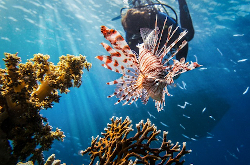라이언피쉬 잡기

Lionfish are known for their beauty and unusual look, a common choice for people showing off the colorful creatures in fish tanks.
But lionfish are also poisonous, with extremely long and separated spines to carry and shoot poison.
The native environment for lionfish includes the South Pacific and Indian Ocean. However, sea experts say lionfish were at some time released into the Atlantic Ocean, likely by people who had kept them in tanks.
Lionfish are currently considered a great threat to coral reefs and related sea life in coastal waters of the southeastern United States and Caribbean.
Scientists say the fish is a top predator that competes for food and space with native fish in the area. Lionfish kill off and eat many other kinds of fish that are important in helping coral reefs grow and stay healthy.
The U.S. National Oceanic and Atmospheric Administration (NOAA) says lionfish reproduce very quickly and are continuing to expand. NOAA scientists predict further reef damage as lionfish keep attacking fish populations already threatened by the effects of climate change, pollution and overfishing.
Now there is a new solution for fighting back. University researchers are developing an underwater robot to hunt down, kill and collect lionfish.
A student-led team at Worcester Polytechnic Institute in Massachusetts developed the robot. The team recently demonstrated the device and is continuing to test and make changes to it.
The team says it used machine learning, advanced computer vision libraries and brain like networks to develop the robot’s vision. It is also equipped to operate underwater without human control.
The robot is designed to recognize the lionfish, chase it and shoot the animal with a spear. The spear then separates from the robot and floats the fish to the surface for collection.
Craig Putnam is a computer science professor at Worcester Polytechnic Institute and a director of the school’s Robotics Engineering Program. He says the robot was built to simplify the process of hunting down and collecting this aggressive fish.
“The goal is to be able to toss the robot over the side of a boat and have it go down to the reef, plot out a course, and begin its search,” he said.
Putnam notes the robot will be required to follow a complex path to avoid the reef, other sea creatures -- and people -- to reach and catch its target. But his team is hopeful the fishlike vehicle can “be a part of the environmental solution” to limit further damage.
Putnam said his team trained the robot system by showing it thousands of images of lionfish in different colors, from many directions and under different lighting conditions. The robot can correctly identify lionfish about 95 percent of the time, he added.
The head of the university’s Robotics Resource Center, Kenneth Stafford, said he is glad the development team was not afraid to take on such a serious environmental problem. “This is a real-world problem and the students attacked it,” he said.
The team said one of the hardest parts of the project was designing a container for the robot’s electronics system. It had to protect it from the harmful effects of saltwater.
In the coming months, the team will be working to perfect the robot’s satellite guidance system.
The researchers hope that in addition to helping reduce reef damage, the system can also provide economic help. They say that since lionfish are a popular food item, fisherman could use the robots to safely catch the fish and sell it to local restaurants.

